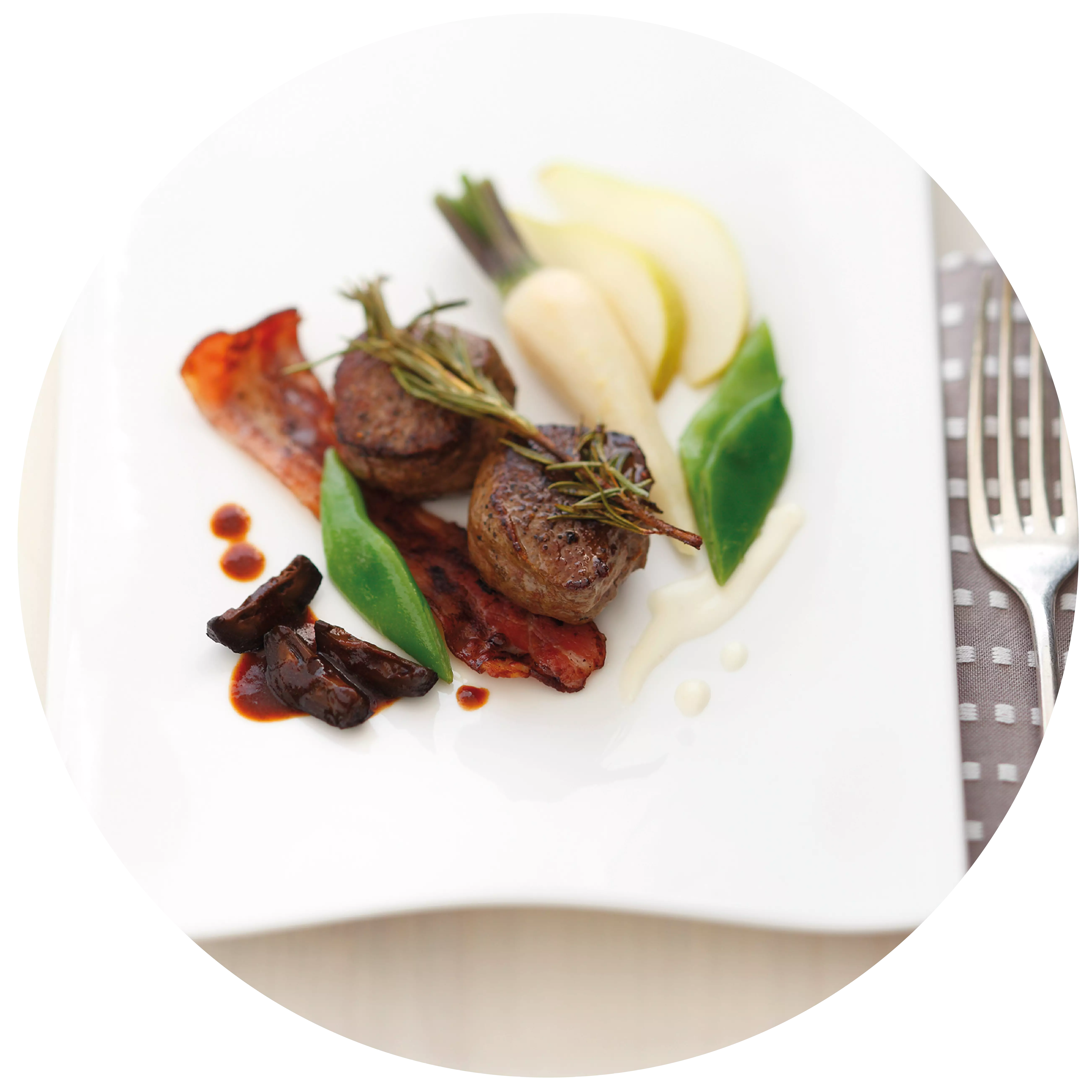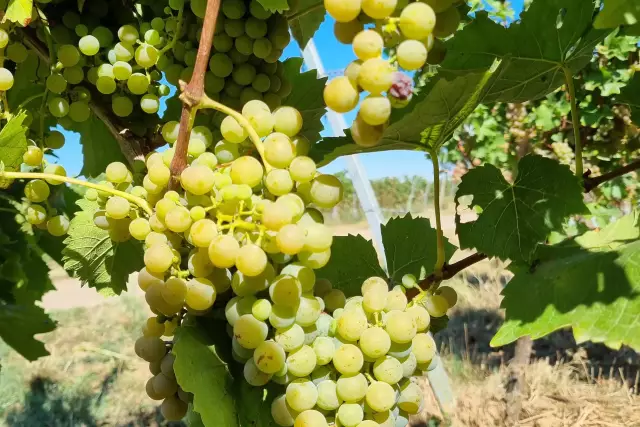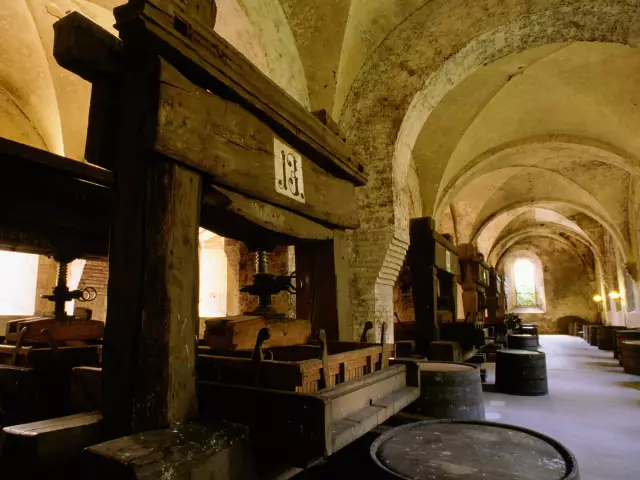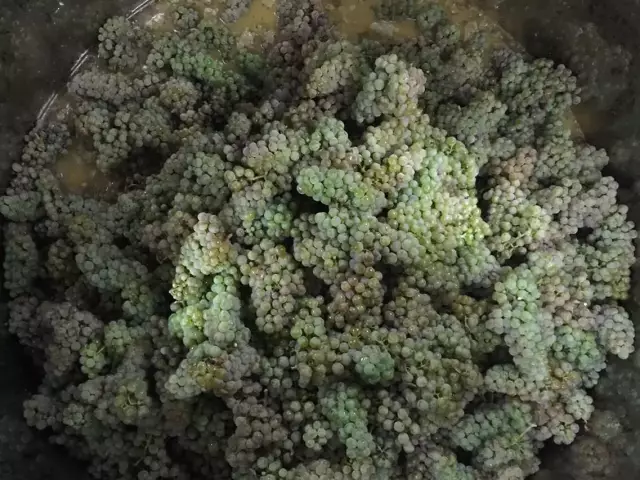Winemaking in the cellar
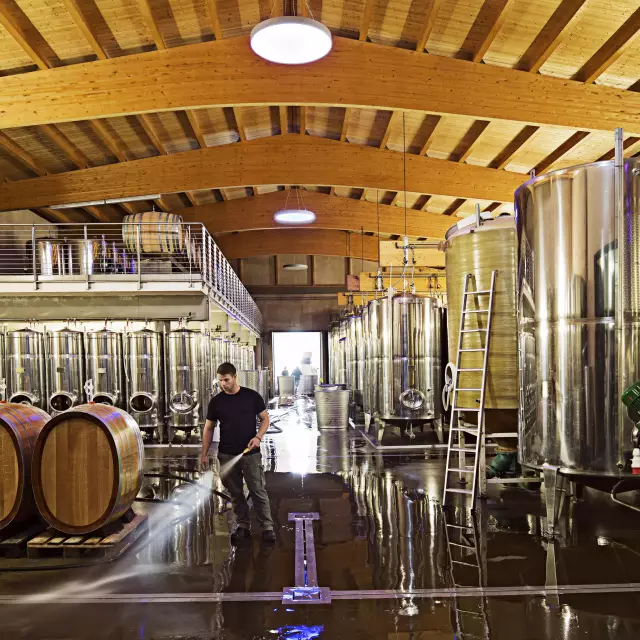
After harvesting, the grapes are crushed and the so-called must is produced.
Facts
-
9g per liter
is the maximum residual sugar for a wine in the "dry" category
-
5,5-15 %
alcohol content a wine is allowed to have
-
5
different taste sensations are perceived by the tongue: Umami, bitter, sour, sweet and salty
Winemaking in the cellar
It is a long journey from the vines in the vineyard to sipping a beautiful wine. A winegrower therefore has three professions: as a winegrower, cellar master and more recently, also as a merchant.
But that's not all. To produce a good wine, one also requires valuable experience passed down through generations, a feeling for nature, zeal, diligence and a precise knowledge of the skills needed by a cellar master.
Masterwork in the cellar
When nature has done its job and the grapes are harvested, it is the task of the cellar master to bring the fine attributes of the grapes, generated in the vineyard, into the wine without loss of quality and to then refine them through the winemaking process. But lets go step be step...
After the harvest, the grapes are first pressed gently. The berries are crushed, creating the so-called ‘mash’. Winemakers seeking quality may de-stem some varieties before pressing (separate the grapes from the stems). For white or rosé wines, the mash is pressed shortly thereafter. These wines are then called light-pressed. Alternatively, for red wine, the mash is fermented or warmed before it is pressed. By pressing the mash, the winemaker obtains the must that still contains sediment.
This must is stored in barrels or tanks and begins to ferment there. Fermentation is started by yeasts, which are a natural component of the grapes and juice. Alcohol and carbonic acid are formed from the conversion of the grapes’ fruit sugar. The naturally available yeasts are often not enough to get the fermentation going, therefore, the winegrowers use so-called pure culture yeasts that were specially developed for winemaking.
Patience is rewarded
Potentially, wine yeast could convert all of the sugar into alcohol, but from 12-15% content, the yeast is "exhausted" and the fermentation is finished. Nowadays fermentation in the cellar is mainly controlled by heating or cooling the tanks or barrels. This makes it possible, among other things, not to let the wine ferment through to the end, but to leave some fructose as residual sweetness.
A residue of fructose can also remain with fully-fermented wines, however the proportion with dry wines is low - maximum 9 grams per liter. In the case of noble sweet wines in the higher Prädikat levels (Auslese, Beerenauslese, Trockenbeerenauslese and ice wine), the residual sugar is very high and can be up to 200 g / l.
After fermentation is complete, the yeast settles on the bottom of the fermentation tank and the clear wine is carefully removed from this sediment. This process is called racking, after which the wine is most often sulfurized to protect it from oxidation. After a certain time, the very last yeast residues and microscopic particles can be filtered out in one or two steps. The wine is now clear and ready to be bottled. Depending on the quality, it can age there for years or even decades as alcohol, acidity and residual sweetness conserve the wine in a natural way. This last stage of creating a top-quality wine requires patience. But as the saying goes: anticipation is the greatest joy!
Click here for short video on bottling.
In the cellar, opinions differ
Nowadays, the winemaker can choose the right type of vinification depending on the grape variety and wine style. In addition to the traditional large wooden barrel, there are also stainless steel tanks which, after their evolution more than 30 years ago, have increasingly found their way into German cellars, as well as the more recent trend for the barrique barrel.
In the end, it is not the container that decides the quality of a wine, but the ability of the cellar master to handle and understand the numerous processes involved in winemaking and bring these all together to a trusted, high quality product. Such sensitivity is rewarded with wonderfully complex and structured wines.
How do barriques, tonneaus and piece barrels differ from each other?
What they all have in common is their material wood. Barriques hold 225l, tonneaus 500l and piece barrels 1,200l. Half-piece barrels hold 600l accordingly and double piece barrels 2.400l.
Varietals

More recipe ideas
Wine recommendation: A white wine with a mellow flavour such as Pinot Gris or Chardonnay. Asparagus risotto al scampi
Risotto with green asparagus, scampi and parmesan.
- 400g Grüner Spargel
- 200g Küchenfertige Scampis
- 200g Risotto-Reis
- 250ml Trockener Weißwein
- 500ml Gemüsebrühe
- 50g Parmesan
- 1 Zwiebel
- 4EL Olivenöl
- 1Dose Safranfäden
- etwas Salz und Pfeffer
Peel the lower third of the asparagus and cut off the ends. Cut into 2 cm long pieces, cook in boiling salted water for approx. 5 minutes and drain. Cut the onion into thin slices and finely chop the garlic.
<p
<p>Heat 2 tbsp of oil, add the onion slices, garlic and rice
.
sauté until translucent. Deglaze with the white wine. Season with salt, pepper
and saffron to flavour. Add a little stock, bring to the boil and simmer, stirring constantly. Gradually add the remaining stock and simmer until the liquid has been absorbed by the rice. The rice should still have a bite on the inside.
Wash the scampi and grate the Parmesan. Heat 2 tbsp oil in a pan and fry the scampi for approx. 4 minutes. Season with salt and pepper. Stir the asparagus, scampi and parmesan into the risotto and serve.
Wine recommendation:
A white wine with a mellow flavour such as Pinot Gris or Chardonnay. Alternatively, a well-chilled, light Trollinger or Blanc de Noir from Pinot Noir.
<p- Pinot Gris (extra brut)
- Chardonnay (extra brut)
- Trollinger (brut)
- Spätburgunder / Pinot Noir (brut)
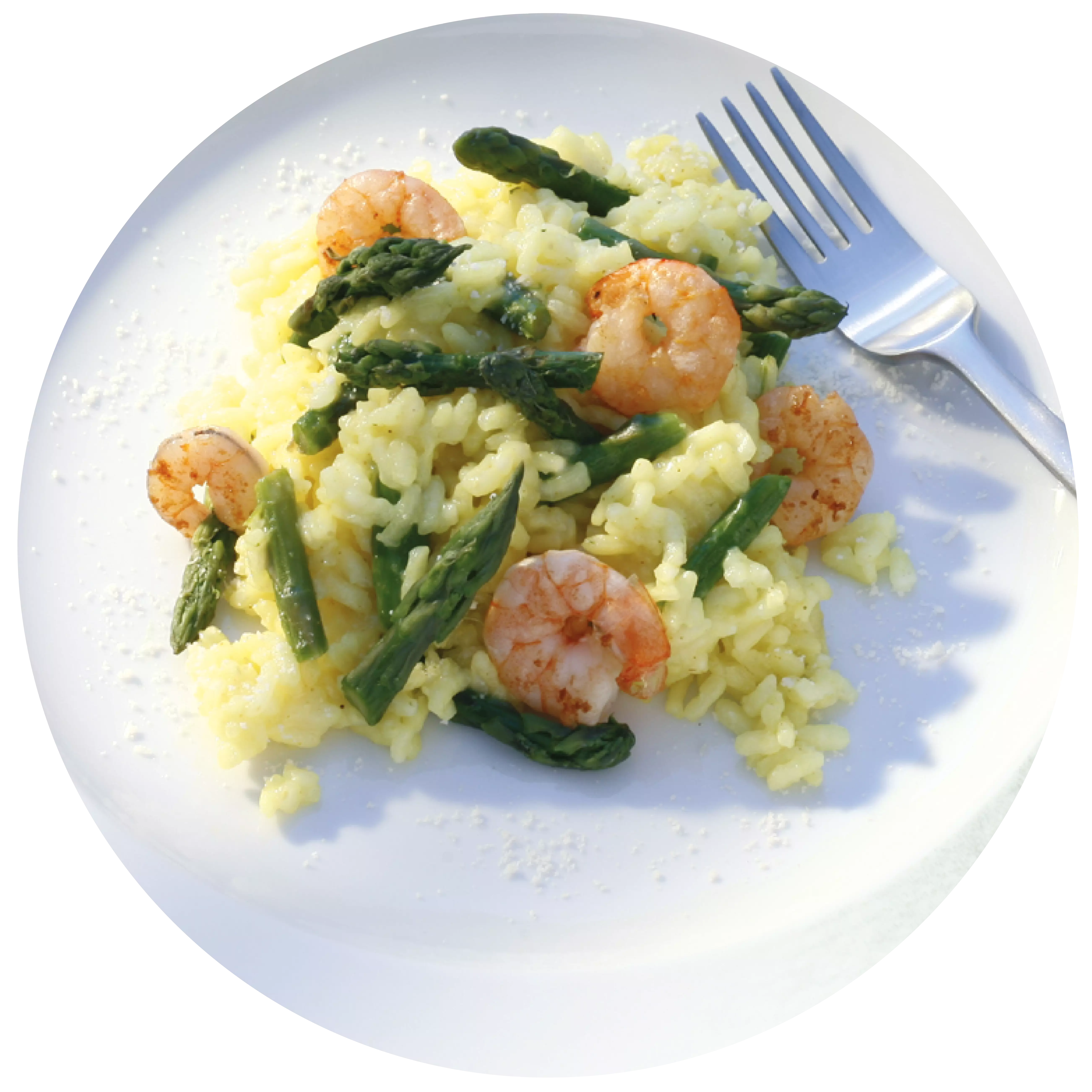
Japanese hollandaise succeeds with wasabi paste Salmon with Japanese hollandaise and green asparagus
Combine salmon with hollandaise and asparagus with a dry Riesling.
- 4x 150g Lachsfilet mit Haut
- 1 Limette
- 2 Zehen Knoblauch
- 4 EL Honig
- 10 EL Sojasauce
- 200g Butter
- 4 Eier
- 1 EL Joghurt
- 2 EL Reisessig
- 2 EL Wasabipaste
- 500 g Grüner Spargel
For the marinade, finely chop the garlic first. Wash the lime in hot water, grate the zest and squeeze out the juice and bring everything to the boil with the honey and soya sauce. Put to one side.
Now prepare the Japanese hollandaise: Bring 180g butter to the boil. Place the egg yolks, yoghurt, rice vinegar, wasabi paste and a pinch of salt in a tall measuring jug and mix with a hand blender. Gradually mix the boiling (!) butter into the egg yolks using a hand blender. Season the hollandaise with salt and pepper to taste and keep the measuring jug warm in hot water.
Peel the bottom third of 500 g green asparagus and cut off the ends. Melt 1 tbsp butter in a large pan. Add the asparagus to the pan, pour in 50 ml water and season with salt and pepper. Cover and bring to the boil briefly.
Fry the salmon fillets on the skin side in a little oil for about 4 minutes. Turn the salmon and fry for a further 2 minutes. Then turn again and baste with the marinade. Remove the salmon from the pan and reduce the marinade until thick. Brush the salmon with it. Serve the salmon with the hollandaise and asparagus. Enjoy your meal!
Wine recommendation:
WINE TIP: Dry Rielsing
- Riesling (trocken)
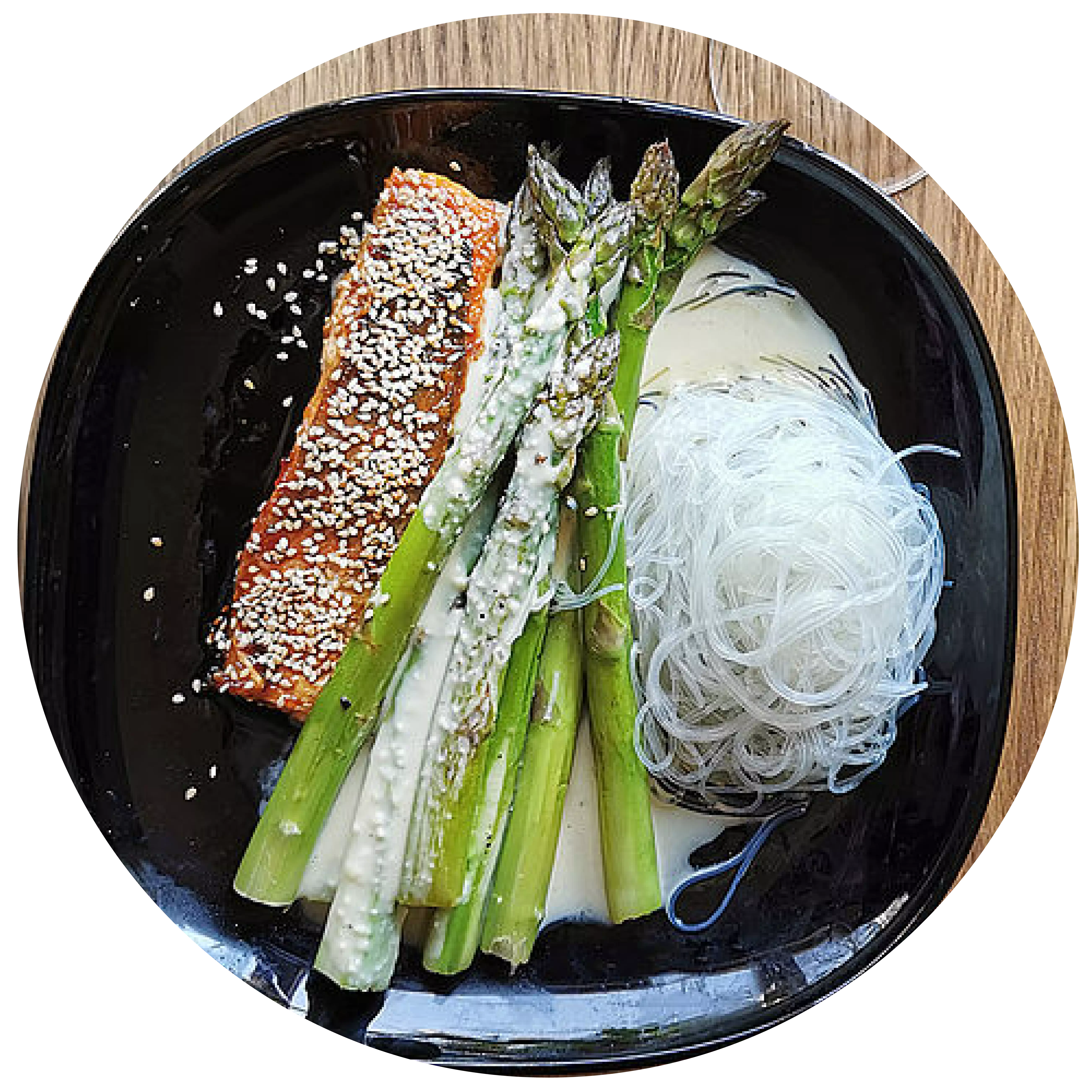
with honey and thyme Goat's cheese tower
with honey and thyme
- 1 großer Apfel
- 1 Rolle Ziegenkäse
- 4 Scheiben Bacon
- 4 TL Honig
- 1 TL Thymian
- 4 Blätter Eichblattsalat
- frische Zweige Thymian zum Garnieren
- nach Belieben Salz & Pfeffer
Preheat the grill to the highest setting.
Fry the bacon slices without fat in a non-stick frying pan until crispy and drain on a piece of kitchen paper. Leave the rendered fat in the pan.
Wash the apple, core it with a corer and then cut it into four, approx. 1 cm thick slices. Slowly fry the apple slices in the remaining bacon fat until just cooked, using the tip of a knife to check the doneness. Place the apple slices in a lightly greased baking dish, sprinkle with thyme and place a crispy fried bacon slice on top of each one.
Divide the goat's cheese into 4 thalers and place one thaler on each apple slice, sprinkle with thyme again and drizzle with 1 teaspoon of honey.
Bake under the grill until the cheese is lightly browned.
Serve the goat's cheese and apple tartlets on a lettuce leaf or, if you prefer, on a bed of lettuce (add a honey-flavoured dressing)
- Dornfelder (halbtrocken & feinherb)
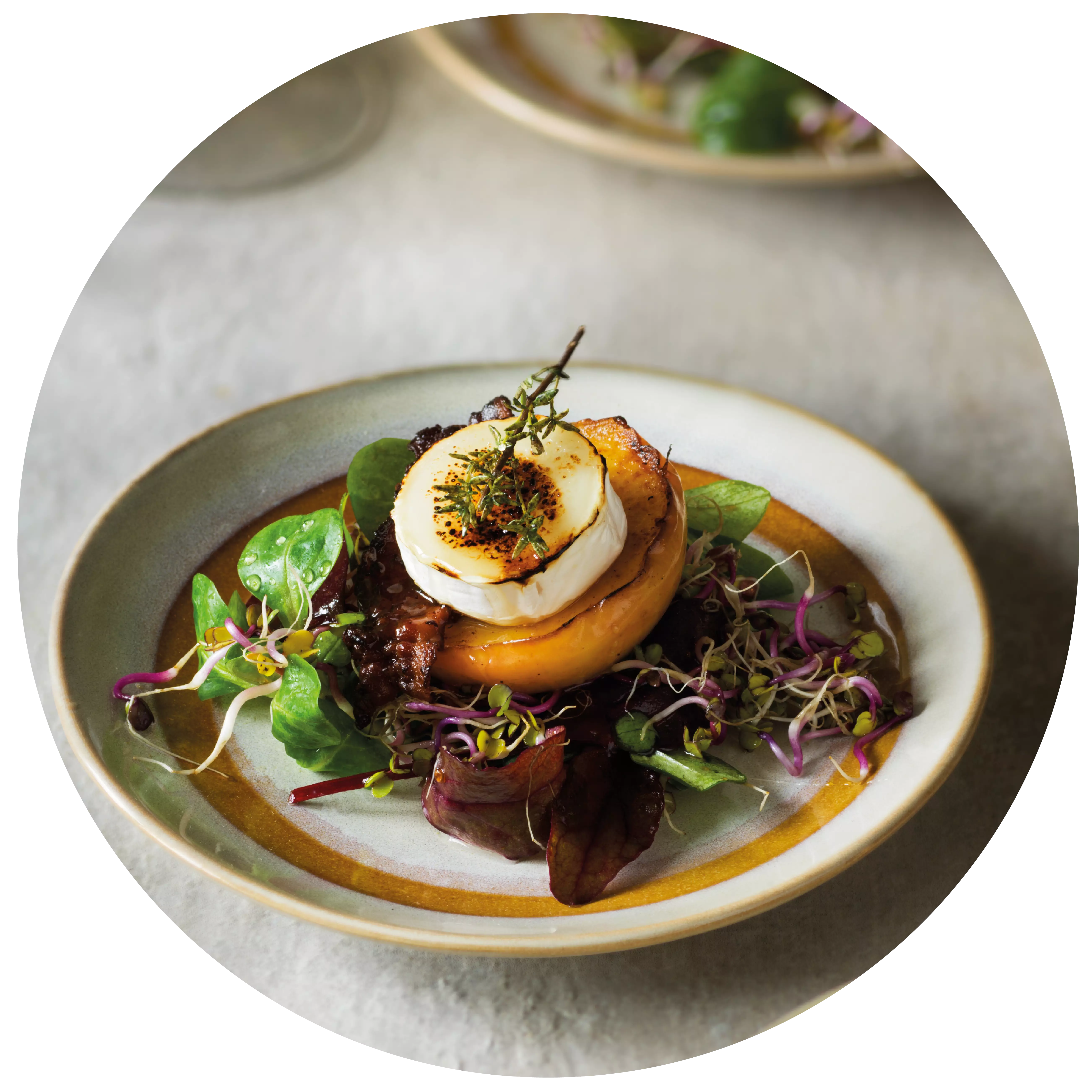
with pears, beans, parsley root and black walnuts Venison medallions
with pears, beans, parsley root and black walnuts
- 12 Stück Rehmedaillions (a 80g)
- 30 Gramm gebratene Speckstreifen
- 200 ml Bechamelsauce
- 3 EL Sonnenblumenöl
- 8 kleine Petersilienwurzeln mit Grün (alternativ Knollensellerie)
- 6 - 8 breite Schnippelbohnen
- 1 große Birne
- 4 - 6 schwarze Walnüsse
- 100 ml Wildfond
- 2 EL Butter
- 2 Stängel glatte Petersilie
- nach Geschmack Salz
Preheat the oven to 180 °C top and bottom heat. Clean, peel and trim the parsley roots. Clean the beans and cut into diagonal pieces. Blanch the parsley roots and beans separately in boiling salted water and rinse immediately in iced water.
Cut the walnuts into eighths and warm in the game stock. Wash the unpeeled pear, cut into eighths, remove the core and cut into thin slices. Fry the venison medallions on both sides in oil, then finish cooking in the oven for approx. 3 - 5 minutes.
In the meantime, toss the beans and parsley roots in melted butter and season with salt. Arrange the vegetables with the black walnuts and pear slices on large plates. Place the medallions on top, garnish with game stock, Béchamel sauce and bacon strips.
Tip: You can make your own black walnuts. To do this, prick the walnuts all over with a fork or skewer and place in water for 10 days. Change the water every day so that the tannic acid can drain off. Boil the nuts 3 times in salted water until they are deep black. Simmer with bay leaves and peppercorns for approx. 20 minutes until soft. Layer in preserving jars and cover with syrup. The nuts can be kept for approx. 1 year.
- Spätburgunder / Pinot Noir (trocken)
- Pinot Gris (trocken)
